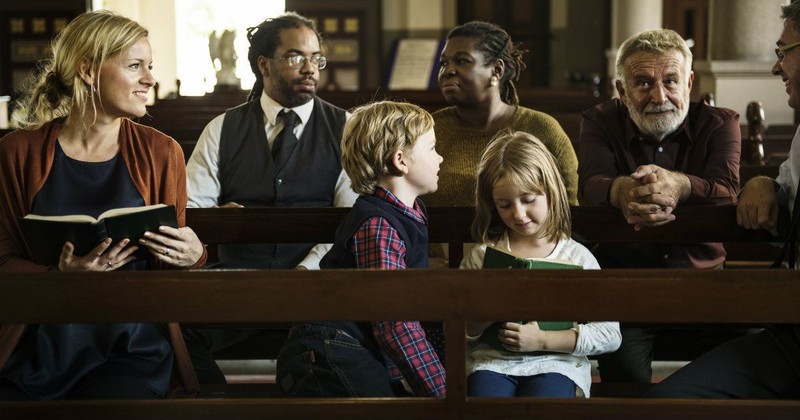
In my twenty-two years of being a Christian, God has called my husband and I to serve in six different churches. As much as each one is different, they also have had one common thread: these churches did not know how to grow. Some desperately clung to old ways of thinking, stunting their ability to grow. Others feared letting more new people in would break- up the relationships they already established.
Whatever the reason, most all of them paid a price: some split, others lost large numbers of people resulting in attendance decline and depressed members. Churches need to reach new people, to grow in diversity and maturity and how they reflect the Kingdom of God. But sometimes they drive away visitors without realizing it. Here is how to recognize 10 ways churches drive away visitors:
Photo Credit: Unsplash

1. Over-prioritizing attracting visitors
All churches must have an awareness of how to reach new people. But some will up the ante on the coolness factor, integrating all the bells and whistles to make church more of a performance and less of an experience with the Lord.
When people are more concerned about wearing the latest fashion trends than the people they are trying to reach, this can become a real problem. There is nothing wrong with making a service that utilizes all contemporary worship and an occasionally simpler message. But when a church becomes all about that, it loses its mission to feed believers with more substance and bring people into maturity.
Photo Credit: Unsplash

2. Lack of Discipleship
In biblical times, the disciples spread the gospel out of the incredible time they spent with Jesus. Today, healings and other spiritual miracles are nearly nonexistent in Western culture. People are seldom equipped in this way. Churches can lose their focus on equipping people to be making disciples of those already amongst them. While numeric growth is always an important factor, discipleship should be at the top of every church’s priority list. When a church puts its focus on making disciples, growth comes naturally.
Discipleship does not always mean more bible studies. While Christians should expand their knowledge of the word, they must also take steps to apply that knowledge to their lives. These steps mean spreading the gospel outside of the church’s four walls. When churches worry more about their attendance increasing instead of people coming to know Christ, that church has lost the point of the mission Christ gave to them.
Photo Credit: Thinkstock

3. Too Many Cliques
Cliques are a natural part of group dynamics. People with a lot in common flock to each other, quickly finding fellowship with each other and bonding as friends. While there is nothing wrong with this, when unnoticed, it does make an unfriendly environment for those visiting for the first time. Those visitors feel like the first day at school trying to find a place to belong.
While cliques are hard to combat, there needs to be a few people willing to step out of their comfort zones and do what they can to welcome strangers into their fellowship. Otherwise, visitors’ needs for intimacy will drive them to find it anywhere they can—even if it means going elsewhere.
Photo Credit: Anyaberkut/Thinkstock

4. Unclear Directions
Because some of the churches I have attended have been in rural areas, many leaders in those churches assume that everyone in town knows where they are located, where the children’s area is or even where the bathrooms are. But unclear directions (including which door to enter into on a Sunday) is essential to attracting (and keeping) visitors. Church members need to approach the church as someone who is entering for the first time. Do you know where to go if you have children? Are singles welcomed? Is there a welcome team who greets the newcomer at the door? Figuring this might be the step needed for visitors to become family.
Photo Credit: Christopher Rusev/Unsplash

5. Unfriendly Congregations
When my husband was looking for a new church for us after we got married and moved to Canada, he visited many churches. With his extroverted personality, he expected many would come up to him to introduce themselves. But after the service, what happened?
No one introduced themselves.
He stood out in the foyer and watched as everyone passed him by, en route to dinner with church friends, not even thinking to include him. When he found the church we eventually attended (and ultimately pastored,) he was bombarded by members who swarmed him before he even set foot into the sanctuary. The church’s commitment to hospitality made my husband feel welcome and chose to be a part of the fellowship.
It is not easy to go up to someone you don’t know, but strangers are fumbling to find their places in the church as well, and your willingness to welcome someone may make or break someone’s establishment in your church.
Photo Credit: Pixabay

6. The Small Church Mentality
Some churches, when faced with a large wave of growth may stop reaching out and soon refuse to grow. For some, this is due to fear that they will not know everyone in church. For some, it is due to fear of change. But churches that refuse to grow become like the dead sea: there is water coming in, but if doesn’t have an outlet, people stagnate in their growth and church attendance declines.
Small churches stay small, much to the joy of existing members. But when their doors close because their attendance declines and established members die, that joy quickly turns to disgruntlement.

7. No Youth Group
Although not every visitor has children, many visitors are families who have children. They want them (no matter what the age) to participate in a strong program for their children to receive a solid foundation upon the word of God as well as be with responsible adults who serve as great role models to mentor their kids.
But small congregations whose median age is older than those who have children don’t attract kids. When there are few children present, there is no need for a church to have a thriving youth group or other children’s church workers. This forces families to find other places to fellowship.
Even small churches can have a good program for children. Enlist the help of a few workers who have hearts for children to transform a small classroom into a learning center for kids. During the town’s community days, the church can set up a table giving out fliers with information about what they offer for kids. Simply getting the word out that they have a heart for kids may be just what they need for a few families to attend, and soon those families invite other families and they turn the entire church around to one that had no kids to one that effectively reaches the next generation.
Photo Credit: Spwidoff/Thinkstock

8. Unrelatable Worship
Some churches can find themselves sticking too closely to a specific era or style of music they are comfortable with, which younger generations may struggle to connect to. Neglecting to diversify the choice of songs and styles of worship can drive younger people away.
Healthy churches are able to strike a balance between hymns and contemporary songs. Hymns are rich in theology and the repetition and simplistic rhythms make them most memorable. Contemporary songs, however, are ones where people can have access to all week. Their simpler choruses can also be memorable and allow members to sing them all week long.
Churches that attract visitors are ones who put aside their own need for their preferred music styles and introduce them to the most popular songs for the sake of new people feeling welcome and having a worshipful experience too.
Photo Credit: Thinkstock

9. Preaching that Focuses on Behaviors Rather than the Heart
The Bible is a love letter from our Heavenly Father to His children. It is a book to interact with, chock full of wisdom to live a righteous life as well as learning from the mistakes of the past so history does not repeat itself. When preachers reduce the Word to a rule book full of do’s and don’ts and neglect teaching on our relationship with God through the text, visitors tend to leave through the doors and never return.
Like worship, healthy churches have pastors who strike a balance between preaching discernment between right and wrong as well as practical application. Members who are being fed know how to instill that wisdom in others. Those are the churches visitors most want to visit.
Photo Credit: Thinkstock

10. A Lack of Vision
Proverbs says, “Where there is no revelation, people cast off restraint; but blessed is the one who heeds wisdom’s instruction.” Successful companies regularly meet and establish where they want to see the company grow in one, five over ten years, However, churches don’t always follow that strategy. When churches live only for the present, they fail to see where God might be leading them, causing them to lose their way and get off track with their vision.
When an unhealthy church loses its vision, it doesn’t do the necessary pulse check to figure out if what they are doing is resulting in people coming to Christ and being baptized. If years have lapsed since a church has seen anyone give their lives to Christ, it will get off course quickly. All churches need to regularly review their vision. They must also have a mission statement outlining specific steps to ensure they are working towards that vision.
Churches are full of people who are doing what they can to spread the Gospel and do God’s work of the Kingdom here on earth. But when the focus shifts to keeping the status quo, visitors come in and out of the church like a revolving door. Churches can successfully invite new visitors but also meet the needs of its established members when they are healthy and balanced.
 Michelle S. Lazurek is an award-winning author, speaker, pastor's wife and mother. Winner of the Golden Scroll Children's Book of the Year, the Enduring Light Silver Medal and the Maxwell Award, she is a member of the Christian Author's Network and the Advanced Writers and Speakers Association. She is also an associate literary agent with Wordwise Media Services. For more information, please visit her website at michellelazurek.com.
Michelle S. Lazurek is an award-winning author, speaker, pastor's wife and mother. Winner of the Golden Scroll Children's Book of the Year, the Enduring Light Silver Medal and the Maxwell Award, she is a member of the Christian Author's Network and the Advanced Writers and Speakers Association. She is also an associate literary agent with Wordwise Media Services. For more information, please visit her website at michellelazurek.com.
Photo Credit: Unsplash
Originally published Thursday, 07 March 2019.









